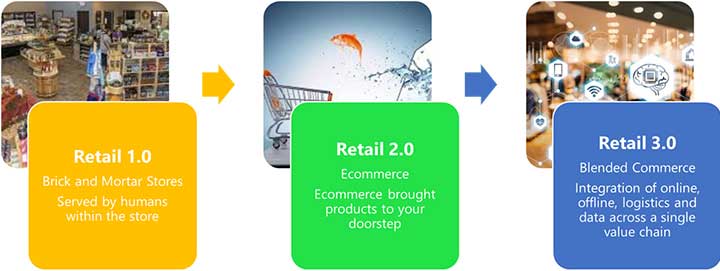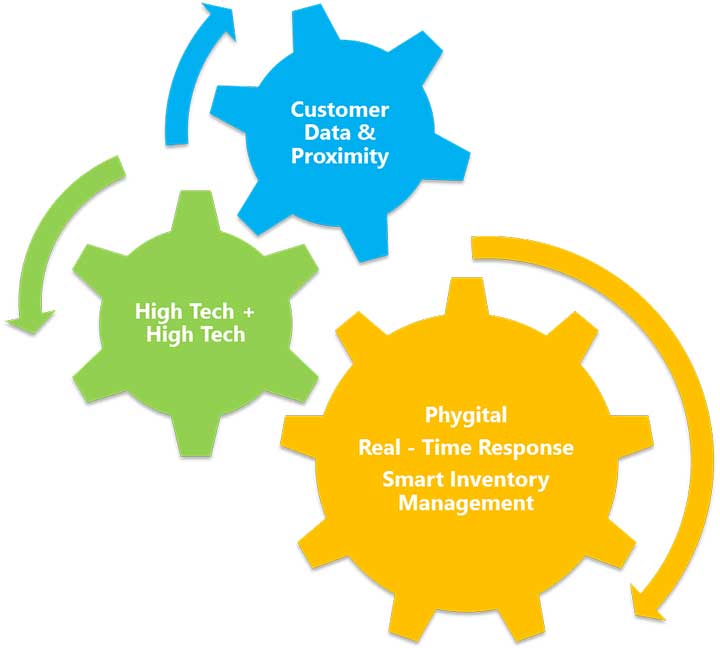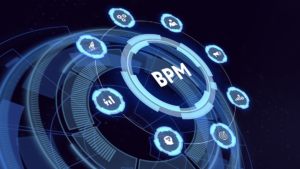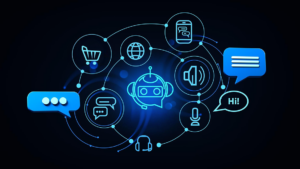

Shobhit Sharma
8 Minutes read
Retail Industry: A Timeline
The story of Retail 1.0 started in 1916. Clarence Saunders, a salesman from the US, visioned and proposed to a distributor to create a store with exposed shelves. Stores where people can view the goods and their prices, move freely in the store along a guided path, and can carry the products independently. Hence came the present day supermarkets in shape. In a matter of just over ten years, the distributor opened more than 2,500 supermarkets in the United States based on the idea of self-service for customers. The American brand Walmart pioneered the idea of the supermarkets further. They introduced ‘Everything under one roof’ stores – a store which could offer all kinds of good/products under one roof.
Retail 2.0 – the era of ecommerce retail, soon replaced and followed Retail 1.0. Ecommerce refers to the buying and selling of goods over the internet using a digital experience platform to transfer money and data to facilitate the transactions involved. Here technology and internet were the real disruptive factors because together they completely transformed the sales/purchase models. We know how Amazon transformed from an online bookstore to the world’s biggest ecommerce platform in the shortest possible time. It was only possible with the use of the most advanced technologies and efficient global supply chain.
In ecommerce, the focus is on customer experience management as an element capable of shifting the balance of the business. From the end of the 90s till today, the concepts of multi-channel and omni-channel have become increasingly popular. It pushed the world towards Retail 3.0 which is characterized by a continuous interweaving between the physical and digital world. Retail 3.0 is basically a blend of regular brick and mortar stores and ecommerce platforms with focus on customer’s experience management on their digital journey.

Retail 3.0: A Brief Overview
Ever since its advent, ecommerce has influenced the retail world tremendously. However, when it comes to Retail 3.0, ecommerce is just one part of the bigger customer experience management strategy. Retail 3.0 requires the integration of online and offline channels, logistics, and data across a single value chain. The dividing line between offline and online is getting thinner. It implies that there are no distinctions between the physical and digital identities of the consumers. Likewise, they are expected to have similar purchasing and customer experience trends, which would be increasingly consistent and personalized. So, irrespective of the channels of interaction in the digital journey of the user, the relationship and communication between a brand and its users is bound to trigger.

Key technologies that are enabling Retail 3.0
- Omni Channel Commerce – An omni-channel shopping experience extends from brick and mortar store to mobile browsing, ecommerce, onsite storefronts, social/digital media and other cross channels.
- AI/ML – AI and ML based technologies like Voice Assistant, Robotic Assistant, Drone Delivery.
- Customer Chatbot – A wide range of chatbots including, Social network bots, monitoring bots, partner bots, searching engine crawler bots, security bots etc.
- IOT – IOT based devices like Security Sensors, Sensors for tracking the status of inventory for sale (temperature, force, etc.), and Network Monitoring. Other sensors with technology for tracking customer digital journey and beacons for location-based marketing.
- Location-based Services – Helps to know when specific customers are in the store. Real-time alerts deploying employees to a location in the store to assist shoppers. Alerts when a customer walks in the door or is in the parking lot to pick up an online order.
- Empowering Store Workers – Devices that empower store workers include Mobile POS devices, handheld mobile computers with scanners, Tablets, Information Kiosk, etc.
- Self-Checkout – Mobile app based checkouts, facial recognition based checkout, assisted checkout
- Click and Collect Model – Retail 3.0 is enabled by the click and collect model which allows the users to do the following:
- Buy in store and ship from store to home
- Buy online and pickup in store
- Buy online and return to store
- Buy in store and return by mail with return label from retailer’s website
- Buy online and pickup at third-party location such as convenience stores and lockers
Key players in the industry and their Retail 3.0 Strategy
Future Group (Easyday)
Generative AI is a branch of artificial intelligence that creates new content like text, images, sound, and code. It learns from large datasets to produce new content. The GPT series, including GPT-3 and GPT-4, is famous for its proficiency in language tasks.
Generative AI has diverse applications, from generating creative content to automating repetitive tasks, and it is finding new roles in areas like disaster recovery, finance, and DevOps.
Alibaba (Hema)
China’s ecommerce giant is rapidly expanding its offline presence in the Brick and Mortar retail space. As part of its Retail 3.0 strategy, Alibaba has introduced a new supermarket brand called ‘Hema’. It primarily focuses on fresh food, including sea food, veggies and fruits. ‘Hema’ stores also have an on-premise kitchen with chefs and a dining area which can accommodate 50-100 people. Shoppers can select their own sea food, send it to the on-premise kitchen to cook and enjoy it in the dining area. Shoppers can also scan the product’s barcode using ‘Hema’ mobile app and know the product’s origin, delivery and nutritional information.
Additionally, Hema also has the facility of mobile app which can suggest similar products based on the scan by the shoppers. The Hema store doubles as warehouse for online orders. Shoppers can make the payment using their smartphones or via Facial Recognition Kiosk. These kiosk will scan their faces and link them to their Alipay accounts to complete the transaction.
Amazon Go – ‘Just Walk Out’ Shopping Experience
Amazon Go gives customers the option to buy goods from physical stores in person rather than through their website. It’s one of a kind physical store where no checkout is required. The store works with an Amazon Go application where the customers go to the store, take the products they want and, leave without any hassle. The entire process is taken care of by the Amazon Go mobile application.
This technology can detect when products are taken or returned to the shelves. It also keeps track of the products in the virtual cart of the customer. When the customers leave the store, their Amazon account is charged and they are sent a receipt for payment.
Amazon is using a combination of Cameras, IoT sensors, AI/ML, computer vision and the data collected from multiple sensors to ensure shoppers are only charged for the products they pick up. The computer vision aspect seems to indicate that there are cameras being used to track the customer in the store.
Conclusion
With the rising consumer demands and digital advances it becomes the need of the hour for the retailers to reimagine and reengineer the retail industry with Retail 3.0. There has been a paradigm shift in the retail world when the future of retail shifted from the debate between online or in-store to the need for digital engagement and seamless customer experience management. Whether it’s an online or a physical store, digital transformation needs to be at the core of every strategy and business models.





